Fish mounts; preserving your trophy fish for the ages. By Dr. Bogus
We all like to memorialize our very special fish. One caught on a trip to an exotic local, an unusual catch or a truly outstanding trophy fish. Most of us take out our digital camera these days take photos from every which angle, post them on Facebook and send in the citation “pink sheet” so we can get a congratulatory proclamation from the governor suitable for framing.
Others want to go one step farther, have a mount made that can be hung on your living room wall, den or man-cave for all to see and marvel at. I recently talked to Dan Ervin, owner of the Dog Island Art Works in Bogue, NC, that specializes in fish mounts and reproductions. But how did Ervin, a former school teacher morph himself into a fish taxidermist? Laughing, Ervin said, “I always have been skinning fish, I grew up a fisherman.”
As it turns out, for Ervin it was a great combination of two loves, art and fishing. “The two have always been very close to my heart,” said Ervin, “so I took the leap and decided to make that my livelihood. I kind of worked to support my fishing habit.” Sure sounds familiar!
As Ervin described to me, there are several options; mounts made from the actual skin of the fish, molded reproductions from an actual fish and reproductions from only pictures and measurements, and fading memories. But regardless of kind of mount pictures are priceless, as Ervin said, “If you can get a couple of photographs and a couple of close-ups and different angles, it’s great, it always helps, especially on a fish like a speckled trout where the markings are different from fish to fish.”
Now the specifics, say I just caught a trophy trout and want a real skin mount what do I do? Ervin suggests to put your fish on ice, or even freeze it then bring it to him. That’s when the artist takes over.
“I’m going to take the skin off,” said Ervin, “remove every bit of flesh, because that’s what holds the oils which will deteriorate in the future, we’re going to tan and preserve that skin, and the head and the fins and then carve a foam form.”
“At this point,” explains Ervin, “I have a fish that’s absolutely flat and it’s very thin, and gray, and lifeless, there’s not much left to the skin when you remove all the flesh. Then after we preserve the skin, it will still be in a damp form and then we will adhere it to the foam form and once that dries, that’s when the coloration begins.”
“Traditionally what a lot of taxidermists do is just use an airbrush,” said Ervin, “but with that you don’t get the depth that you need with just an airbrush, and so I use hand paints, powders, charcoals, watercolors, oils and I do use an airbrush, but I use it sparingly, because we really want to create that depth and realism that every single scale has.”
Finally the skin mount is sealed with a lacquer based or epoxy sealer to give that desired high gloss “wet” look like it just came out of the water, and then mounted or a board, or tree stump or other natural habitat for effect.
If it is longevity and detail you want, Ervin suggests a reproduction mount. “Reproductions, explained Ervin, “are molded directly off a newly dead fish, and then fiberglass is made into that mold, so you have all the detail of the freshest fish in a reproduction. We are basically using the process they use to make fiberglass boats. So now it comes in as a white “canvas” and that’s where it really takes a lot effort to get the depth and realism. I spend a lot more time coloring a reproduction but it pays off.”
Dolphin Mold
Of course if you don’t have a fish to work from, just memories and photos, Ervin can handle that too. As Ervin pointed out, “If a wife says, my husband caught this sailfish 10 years ago, and he’s always wanted a mount.” Ervin can get as close as he can using just measurements and pictures, and then add the coloration. There are reproduction “blanks”, which are fiberglass, available commercially for just about any fish and nearly any size and dimensions to work from.
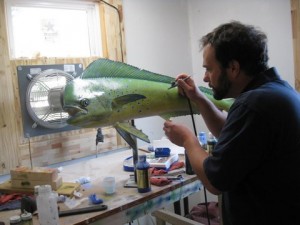 Air Brush the Finishing Touches
Air Brush the Finishing Touches
I wondered which mounts were among his favorites or most memorable, “Well, said Ervin, “I’ve just finished doing a great little bluegill (below), as tiny as they are, I don’t know that there is a prettier fish that swims, I love doing them. 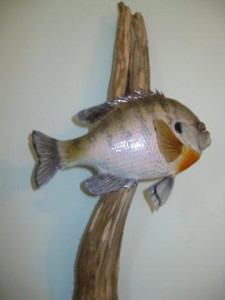 Then there was the 80-inch sailfish there at the opposite end,” chuckled Ervin, “and boy do they use a lot of paint!”
Then there was the 80-inch sailfish there at the opposite end,” chuckled Ervin, “and boy do they use a lot of paint!”
Advantages and disadvantages of the different kinds of mounts and reproductions.
Skin Mounts, Advantages:
-Fish can be filleted and eaten
-You use parts of the actual fish that was caught
-Some of the unique characteristics of the fish will naturally remain
-Costs are often less than reproductions
Skin Mounts, Disadvantages:
-Some oils may leak through over time and cause some discoloration or skin shrinkage
-Some fish like pompano are delicate and make it difficult to remove the skin
-Fish over 30″ often contain too much oil in their skin to make mounts that will not show shrinkage or deterioration over time
Reproductions, Advantages:
-Fish can be released unharmed or kept and eaten
-Mount will never deteriorate
-You can mount a fish you caught in the past or one that was not preserved well enough to skin mount
-You can purchase one for decor without having caught the fish
Reproductions, Disadvantages:
-Usually more costly than a skin mount
-You have to use a reputable wildlife artist or you can get a reproduction with very little detail, giving you poor results

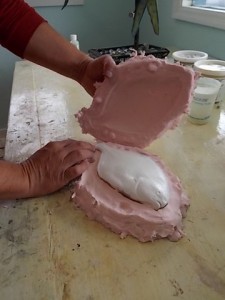
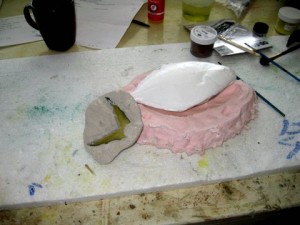
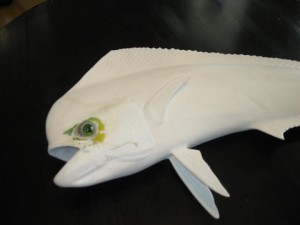
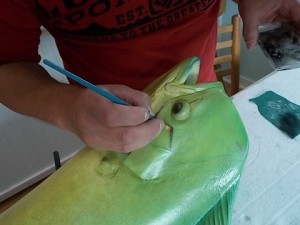
Gregg
Hello Sir, very good information. I’m interested in large 50 lb carp being mounted but not a reproduction. You mentioned that over 30″ the fish has more oil and that will cause the skin to shrink more and discoloration. If cost were not a factor, what would I have to do to mount a large carp without a reproduction? That is my goal to figure this out; going to catch many Asian Carp this Spring and practice on them with various techniques for mounting without reproduction. I’m trying to “think outside the box” and find a way to mount large carp.
1. Preserve the fish on ice and then soak it in Water Sealant (Thompsons) so the scales stay intact then precede with the normal taxidermy methods; maybe even spray water sealant in the interior?
2. Soak the entire fish in formaldehyde before taxidermy procedures?
Please give me some possible ideas to investigate.
I thank you kindly for your time.
Gregg
Doc
Check out http://www.dogislandartworks.com/